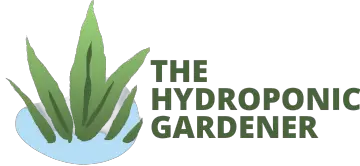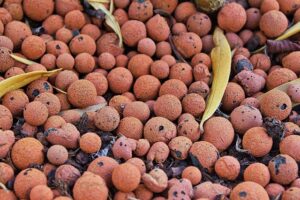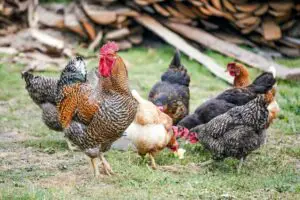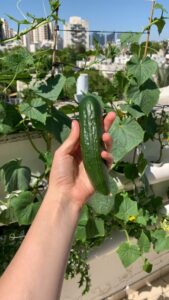Are you intrigued by the idea of growing plants without soil? Hydroponic gardening is a fascinating method that allows you to do just that. Instead of relying on traditional soil, hydroponics utilizes specialized growing media to support plant roots and provide essential nutrients.
If you’re new to the concept of hydroponic gardening and the world of growing media, we’re this article is here to guide you through the basics.
We will explore what it is, why it’s essential in this innovative cultivation method, and the benefits it offers. Let’s get to it.
What is Hydroponic Gardening?
Hydroponic gardening is a method of growing plants without soil, using nutrient-rich water as the growing medium instead. In these systems, plant roots are directly exposed to a nutrient solution that is delivered to them through various methods such as submersion in a nutrient-rich solution or a drip irrigation system.
The nutrients are dissolved in the water, and the plants absorb them directly through their roots. This gardening method has several benefits, including better control over nutrient levels, reduced water usage, and higher yields due to faster plant growth. Hydroponic gardening can be done indoors, outdoors, or in greenhouses, and it is becoming increasingly popular due to its many advantages over traditional soil-based gardening methods.

What is Hydroponic Growing Media?
This is the material used to support and anchor the roots of plants in a hydroponic system, as there is no soil to hold them in place. These media also serve as a reservoir for nutrient-rich water, and it can help to maintain a suitable pH level around the roots.
Hydroponic growing media come in various forms, such as natural or synthetic materials, and they have different properties depending on their composition. Some examples include rockwool, perlite, vermiculite, coconut coir, clay pebbles, and expanded shale.
Each type of hydroponic growing medium has unique characteristics that make it suitable for different types of systems. For example, clay pebbles are often used in ebb and flow systems to provide good drainage, while rockwool cubes are commonly used in drip irrigation systems to retain moisture well.
Types of Hydroponic Growing Medium
Inert Media
Inert media refers to growing media that do not contain any inherent nutritional value or biological activity.
These media do not contribute significantly to the nutrient content of the hydroponic solution but serve as a supportive structure for plant roots. Inert media are designed to provide stability, aeration, and drainage for the roots while allowing the hydroponic nutrient solution to flow freely around them.

1. Rockwool
Made from volcanic rock or limestone, rockwool is widely used due to its excellent water retention and good aeration properties. It provides a stable structure for the roots to anchor and allows for optimal nutrient uptake.

2. Perlite
Perlite is a lightweight material that promotes drainage while retaining some moisture. It consists of volcanic glass that has been heated to form porous granules. Perlite helps improve aeration and prevents water logging of the root system.
3. Vermiculite
Similar to perlite, vermiculite is a lightweight material with good water retention properties. It aids in moisture regulation and provides adequate aeration for the roots. Vermiculite is often used in conjunction with other growing media to create a balanced mixture.

4. Coconut Coir
Derived from the fibrous husk of coconuts, coconut coir is a sustainable and popular growing medium. It retains water well, has good aeration, and has a balanced pH. Coconut coir is often mixed with other media to improve its drainage capacity.
5. Floral foam
Although primarily used for cut flowers in floral arrangements, floral foam can be utilized as a temporary growing medium in hydroponic systems. However, it is not ideal for long-term use as it lacks the necessary structure and nutrient-holding capacity for optimal plant growth.
6. Porous media (e.g., clay pebbles)
Porous media, such as clay pebbles, are popular in hydroponics due to their excellent drainage and aeration properties. They provide a stable foundation for the roots while allowing ample oxygen flow. Clay pebbles are particularly suitable for systems like deep water culture (DWC) or flood and drain setups.
Soilless Mixes
Soilless mixes are popular in these systems because they provide better control over the growing conditions, nutrient content, and pH levels compared to soil-based cultivation. They allow for precise water and nutrient delivery management, which can result in enhanced plant growth and higher yields.
Typically, soilless mixes are made up of a combination of materials such as peat moss, coconut coir, perlite, vermiculite, and various organic amendments.
These materials are selected for their ability to retain moisture, provide aeration, and support root development. Soilless mixes offer a balanced environment where plant roots can access oxygen, water, and nutrients without the risk of over-saturation or nutrient imbalances.

1. Peat Moss
Peat moss is a natural, lightweight, and highly absorbent material that retains water well. It helps improve moisture retention in the root zone while allowing for adequate drainage. Peat moss is often used in soilless mixes due to its excellent water-holding capacity and ability to maintain a stable pH level.

2. Compost-based mixes
Compost-based mixes incorporate organic compost or well-decomposed plant matter into the growing medium. These mixes offer a rich source of nutrients and beneficial microorganisms that enhance plant growth. Compost-based mixes contribute to soil fertility, water retention, and overall plant health.
3. Peat-based mixes
Peat-based mixes are blends primarily consisting of peat moss and other additives like perlite, vermiculite, or coco coir.
These mixes provide a balanced combination of water retention, aeration, and nutrient availability. Peat-based mixes are known for their ability to hold moisture while still allowing excess water to drain away.
Aggregate Media
Aggregate media serve multiple purposes in hydroponic systems. They provide structural support for the plants, ensuring stability and anchorage.
Additionally, they create a well-aerated environment for the roots, allowing for optimal oxygenation and preventing waterlogging. Furthermore, aggregate media facilitate efficient nutrient and water distribution to the plants.
Aggregate media are used in systems such as flood and drain (ebb and flow), deep water culture (DWC), and drip irrigation. They allow for easy circulation and recirculation of nutrient-rich water, facilitating the delivery of essential elements to the plants.

1. Expanded Clay Pellets
Expanded clay pellets, also known as hydroton or clay pebbles, are lightweight, porous clay balls that are heated and expanded.
They have a high water retention capacity while maintaining good aeration for the roots. Expanded clay pellets provide plant stability, promote root development, and allow for excellent drainage.

2. Lava Rock
Lava rock, also called volcanic rock, is a natural, lightweight aggregate media commonly used in hydroponics. It provides good drainage, aeration, and stability for plant roots. Lava rock has a porous structure that retains moisture while allowing excess water to flow through easily, preventing waterlogging.
3. Growstones
Growstones are an eco-friendly and sustainable alternative to traditional aggregate media. They are made from recycled glass and have a porous, irregular shape, providing excellent air space for root growth. Growstones are lightweight, retain moisture well, and promote good drainage.

4. Rice Hulls
Rice hulls are the outer protective layer of rice grains. They can be used as an aggregate media in hydroponics due to their lightweight nature and good drainage properties.
Rice hulls help improve aeration in the root zone and prevent compaction. However, they have low water retention capacity and are often used with other media to create a balanced growing environment.
Benefits of Using Hydroponic Growing Media
Hydroponic growing media offer several benefits that contribute to the success and efficiency of hydroponic gardening. Here are the key advantages.
1. Improved water and nutrient retention
They can retain water and nutrients, providing a consistent and readily available supply to the plant roots. This ensures that plants receive the necessary hydration and essential nutrients for healthy growth.
2. Enhanced root aeration and oxygenation
They promote excellent aeration and oxygenation of the plant roots. The media’s structure allows for the proper exchange of gasses, preventing root suffocation and enhancing root development.
3. Better control over pH and nutrient levels
They enable precise control over the pH and nutrient levels in the root zone. This allows growers to create an optimal growing environment tailored to the plants’ specific needs, ensuring they receive the right balance of nutrients for optimal growth and productivity.
4. Reduction of pests and diseases
Using inert media reduces the risk of pests, diseases, and weeds commonly associated with soil-based gardening. The absence of soil eliminates the habitat for many pests and pathogens, leading to healthier plants and reduced reliance on pesticides.
5. Reusability and sustainability
They, such as inert media like clay pellets or rock wool, can be reused multiple times with proper sterilization and maintenance.
This reusability factor makes hydroponic systems more sustainable and environmentally friendly than traditional soil-based cultivation.
Factors to Consider in Choosing Hydroponic Growing Media
When choosing a growing medium, it’s important to consider several factors that can impact the success of your hydroponic system. Here are some key factors to consider:
1. Water retention and drainage properties
The medium should have a balance between water retention and drainage. It should hold enough water for the plants’ needs while allowing excess water to drain away, preventing waterlogging and root rot.
2. pH buffering capacity
The medium should be able to stabilize and buffer the pH of the nutrient solution. This helps maintain the optimal pH range for nutrient uptake by the plants and prevents fluctuations that can negatively impact plant health.
3. Sterility and resistance to pests and diseases
Choose a growing medium that is sterile and free from pests, diseases, and weed seeds. This reduces the risk of introducing harmful organisms into your hydroponic system, promoting healthier plant growth.
4. Sustainability and environmental impact
Consider the sustainability and environmental impact of the growing media. Look for options that are renewable, recyclable, or made from recycled materials. Avoid media that may harm the environment during production or disposal.
5. Compatibility with the chosen hydroponic system
Ensure that the growing media is compatible with your specific hydroponic system. Different systems may require different media to facilitate proper water circulation, root support, and nutrient delivery. Consider the size and structure of the media that works best with your chosen system.
Examples of Hydroponic Systems and Appropriate Growing Media
1. Deep Water Culture (DWC) – Expanded clay pellets, Rockwool
Deep Water Culture (DWC) is a popular hydroponic system that suspends plant roots in a nutrient-rich water solution.
This system is known for its simplicity and effectiveness in promoting healthy plant growth. In DWC, the plant roots are constantly submerged in oxygenated water, allowing for optimal nutrient uptake and oxygenation.
The setup of a DWC system typically consists of a reservoir or tank that holds the nutrient solution and supports one or multiple buckets or containers.
These buckets are filled with a growing medium, often expanded clay pellets, which provide support to the plants and allow for root oxygenation. The plant roots grow through the medium and dangle directly into the nutrient solution.
Maintaining the proper oxygen levels in the DWC system is crucial. This is typically achieved by using an air pump and air stones to introduce oxygen into the nutrient solution continuously. The oxygen bubbles created by the air stones help to oxygenate the water, providing the roots with the necessary oxygen for respiration.
In terms of maintenance, DWC systems require regular monitoring of the nutrient solution’s pH and nutrient levels to ensure they remain within the optimal range for plant growth. The water level in the system should also be checked regularly and topped up as needed to ensure the roots remain submerged.
2. Nutrient Film Technique (NFT) – Rockwool, Coco coir
NFT systems utilize a shallow, continuously flowing nutrient solution that circulates along a sloped channel, with the plant roots partially submerged. Rockwool and coco coir are commonly used as growing media in NFT systems, as they provide good water retention and allow for root development.
The Nutrient Film Technique (NFT) is a hydroponic system that continuously flows a thin film of nutrient solution over the plant roots, providing them with a constant supply of water, oxygen, and nutrients. This technique is popular for its efficient use of water and nutrient resources and is commonly used for growing leafy greens, herbs, and smaller plants.
In an NFT system, plants are typically grown in channels or troughs that are slightly inclined to allow the nutrient solution to flow along the bottom while exposing the roots to the film of solution. A growing medium supports the roots, and in the case of NFT, Rockwool and Coco coir are commonly used.
In NFT systems, the nutrient solution is pumped to the highest end of the channel and flows down through the roots, allowing the plants to absorb the necessary water and nutrients. The excess solution is then collected and recirculated back to the nutrient reservoir for reuse, resulting in minimal water wastage.
Proper maintenance of an NFT system involves monitoring the pH and nutrient levels of the solution, ensuring that they are within the appropriate range for plant growth. Regular inspection of the channels and roots is also important to identify and address any blockages or issues that may hinder the flow of the nutrient solution.
3. Drip Irrigation – Perlite, Coconut coir, Soilless mixes
Drip irrigation is a widely used hydroponic system that delivers a controlled amount of nutrient-rich water directly to the plant’s root zone through drip emitters or micro-tubing.
This method ensures precise watering and nutrient delivery, making it suitable for various plants, including vegetables, fruits, and herbs.
The selection of growing media in a drip irrigation system depends on factors such as the plant’s water requirements, desired moisture retention, and the overall system’s needs. It’s important to choose media that can effectively deliver water and nutrients while ensuring proper oxygenation for the roots.
Drip irrigation systems offer several advantages, including precise control over the watering schedule, reduced water wastage, and efficient nutrient delivery. Using appropriate growing media enhances these benefits by optimizing root health and nutrient uptake.
Proper maintenance of a drip irrigation system involves monitoring and adjusting the water and nutrient levels to meet the specific requirements of the plants. Regular inspection of the emitters, tubing, and growing media is necessary to ensure proper functioning and prevent clogs or blockages.
4. Aeroponics – Growstones, Rockwool
Aeroponics is an advanced hydroponic system that involves suspending plant roots in the air and misting them with a nutrient-rich solution.
This technique provides plants with a highly oxygenated environment, allowing for optimal nutrient absorption and faster growth. In aeroponics, the choice of growing medium is crucial to support the plant’s root structure and facilitate nutrient delivery.
Both Growstones and Rockwool offer several advantages in aeroponics. They provide a supportive structure for the plant roots while ensuring adequate oxygenation and nutrient delivery.
These media help maintain a moist environment around the roots without drowning them, promoting healthy growth and efficient nutrient absorption.
In aeroponic systems, it is essential to maintain the misting intervals and nutrient concentration to ensure the roots receive an adequate supply of water and nutrients. Regular monitoring of the growing media is necessary to prevent any blockages and maintain optimal moisture levels.
5. Ebb and flow Systems
Ebb and flow systems, also known as flood and drain systems, are a popular type of hydroponic system that provide periodic flooding and draining of the plant roots. This cyclic action allows for efficient nutrient uptake and oxygenation, promoting healthy plant growth.
In the ebb and flow systems, the choice of growing media is essential to support the plants and facilitate the flooding and draining process.
The ebb and flow system works by periodically flooding the grow tray with a nutrient solution and then draining it back into a reservoir. This flooding and draining action ensures that the roots access water, nutrients, and oxygen.
The growing media, such as expanded clay pellets or rockwool, holds the moisture and nutrients for the plants during the flooding phase and allows excess water to drain away during the draining phase. This process helps prevent waterlogging and ensures the roots receive the right balance of nutrients and oxygen.
Ebb and flow systems are versatile and can accommodate a wide range of plant types. They are suitable for both small-scale and large-scale hydroponic setups.
The choice of growing medium in these systems depends on factors such as plant species, system size, and personal preferences. It is important to select a medium that provides adequate support for the plants, promotes good drainage, and retains enough moisture for healthy root development.
Reservations In Using Hydroponic Systems
I. Cost
Some hydroponic growing media can be expensive, especially when starting with a large-scale hydroponic system. The initial investment in quality media can be higher compared to traditional soil-based gardening.
II. Disease and Pest Risk
Certain growing media can sometimes harbor pests, pathogens, or fungi that may affect plant health. Selecting sterile or properly treated media to minimize these risks is crucial.
III. pH and Nutrient Imbalances
Some types of growing media may have inherent pH or nutrient imbalances. This requires careful monitoring and adjustment to maintain the optimal growing conditions for plants.
IV. Environmental Impact
Certain hydroponic growing media, such as rockwool or synthetic materials, may have environmental concerns associated with their production and disposal. It is important to consider the sustainability and eco-friendliness of the chosen media.
V. Learning Curve
Each type of hydroponic growing media requires specific knowledge and techniques for successful implementation. A learning curve may be involved in understanding the characteristics, watering requirements, and management techniques for each medium.
VI. Limited Plant Support
Certain types of hydroponic growing media, like rockwool or coco coir, may not provide substantial support for plants with heavy fruit or vining growth. Additional support systems, such as trellises or cages, may be required.
Nutrients to use in a hydroponic system
In a hydroponic system, essential nutrients are provided to the plants directly through the nutrient solution. The specific nutrients required for healthy plant growth include:
Macronutrients
Macronutrients are essential elements plants require in relatively large quantities for their growth and development. The three primary macronutrients are:
- Nitrogen (N): Nitrogen promotes leaf and stem growth. It is key in protein synthesis, chlorophyll production, and overall plant vigor.
- Phosphorus (P): Phosphorus is essential for plant energy transfer and storage. It supports root development, flower formation, and fruiting. It also aids in DNA and RNA synthesis.
- Potassium (K): Potassium is involved in various physiological processes, including photosynthesis, water regulation, and enzyme activation. It helps strengthen plant structure, enhances disease resistance, and improves fruit quality.
These macronutrients are typically provided to hydroponic plants in a balanced nutrient solution to ensure optimal growth and productivity. Monitoring and adjusting the nutrient levels based on plant needs is crucial for maintaining a healthy nutrient balance in the hydroponic system.
Secondary nutrients
Secondary nutrients are essential elements plants require in moderate quantities for proper growth and development. The three primary secondary nutrients are:
- Calcium (Ca): Calcium plays a crucial role in cell wall formation, cell division, and overall plant structure. It helps prevent diseases, promotes root development, and enhances nutrient uptake.
- Magnesium (Mg): Magnesium is a central component of chlorophyll, the pigment responsible for photosynthesis. It is vital for energy production, enzyme activation, and synthesizing carbohydrates and proteins.
- Sulfur (S): Sulfur is necessary for forming amino acids, proteins, and enzymes. It plays a role in chlorophyll synthesis, root growth, and overall plant health. Sulfur also contributes to the flavor and aroma of certain crops.
Micronutrients
Micronutrients are essential elements plants require in very small quantities for proper growth and development. These elements, also known as trace elements, include:
- Iron (Fe): Iron is essential for chlorophyll production and is critical in photosynthesis. It is involved in enzyme activation and energy transfer within the plant.
- Manganese (Mn): Manganese is necessary for various metabolic processes, including the synthesis of chlorophyll and enzymes involved in nitrogen metabolism. It also plays a role in the formation of plant cell walls.
- Zinc (Zn): Zinc is crucial for synthesizing plant hormones and enzymes involved in various metabolic reactions. It supports root development, seed formation, and overall plant growth.
- Copper (Cu): Copper is involved in photosynthesis and acts as a catalyst for various enzymatic reactions. It plays a role in synthesizing lignin, a component of plant cell walls.
- Molybdenum (Mo): Molybdenum is necessary for nitrogen fixation and the conversion of nitrates into proteins. It plays a vital role in enzyme activity and helps plants utilize nitrogen efficiently.
- Boron (B): Boron is involved in cell division, carbohydrate metabolism, and the transport of sugars within the plant. It supports pollen formation, fruit development, and calcium uptake.
- Nickel (Ni): Nickel is required for the metabolism of urea, a nitrogen compound found in plants. It plays a role in enzyme activity and overall plant growth.
Although micronutrients are required in small quantities, they are essential for the proper functioning of various biochemical processes in plants. Ensuring the presence of these micronutrients in the nutrient solution is crucial for preventing nutrient deficiencies and promoting healthy plant growth in hydroponic systems.
How take care of your grow medium
Taking care of your grow medium in a hydroponic system is crucial for the health and success of your plants. Here are some essential tips to help you maintain and care of it:
- Proper Cleaning and Sterilization
Before using a new medium, make sure to clean and sterilize it thoroughly. This helps eliminate any potential contaminants and provides a clean environment for your plants. Follow the manufacturer’s instructions or use appropriate cleaning solutions to ensure proper sterilization.
- Regular Inspections
Regularly inspect your medium for any signs of algae, mold, pests, or disease. Promptly address any issues you encounter to prevent further spread or damage. Regular inspections help you catch problems early and take necessary corrective measures.
- Monitor Moisture Levels
Maintain proper moisture levels in your medium. Avoid overwatering, as it can lead to waterlogging and suffocate the roots. Conversely, ensure the medium doesn’t dry out completely, as it can stress the plants. Regularly check and adjust the moisture levels as needed based on the specific requirements of your plants.
- Flushing
Periodically flush the medium to remove accumulated salts, mineral deposits, or excess nutrients. Flushing helps prevent nutrient imbalances and ensures optimal nutrient uptake by the plants. Follow recommended flushing guidelines specific to your grow medium and the stage of plant growth.
- Nutrient Management
Manage nutrient levels in your hydroponic system to prevent nutrient buildup or deficiencies in the growing medium. Monitor and adjust nutrient solutions based on the growth stage of your plants and their specific nutrient requirements. Avoid excessive use of fertilizers, as it can lead to nutrient imbalances and damage the roots.
- Crop Rotation and Replacement
If you practice crop rotation in your hydroponic system, clean and sanitize the grow medium between crops to minimize the risk of disease transmission. Additionally, consider replacing the medium periodically to maintain its effectiveness and prevent the accumulation of pathogens or organic matter.
- Proper Storage
Store your grow medium in a clean and dry area to prevent contamination or moisture absorption. Follow storage instructions provided by the manufacturer to maintain the quality and integrity of the medium.
- Replacement
Over time, grow media can break down or become compacted, reducing its effectiveness and potentially harboring pathogens. Consider replacing the grow medium when you notice signs of deterioration or at the start of a new growing season.
Hydroponic growing media are vitally important materials. They offer numerous benefits and can be organic or inorganic, natural or synthetic, and reusable or disposable. Choosing a suitable growing medium depends on the type of system, crop, and your preference. With this guide, you can successfully pick the best option for your garden and grow healthy and productive plants without soil.






